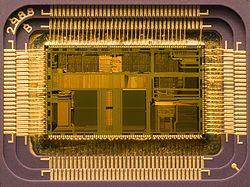
Intel 80486DX2
Encyclopedia

Central processing unit
The central processing unit is the portion of a computer system that carries out the instructions of a computer program, to perform the basic arithmetical, logical, and input/output operations of the system. The CPU plays a role somewhat analogous to the brain in the computer. The term has been in...
produced by Intel that was introduced in 1992. The i486DX2 was nearly identical to the i486DX but for the addition of clock multiplier circuitry. It was the first chip
Integrated circuit
An integrated circuit or monolithic integrated circuit is an electronic circuit manufactured by the patterned diffusion of trace elements into the surface of a thin substrate of semiconductor material...
to use clock doubling, whereby the processor runs two internal logic clock cycles per external bus cycle. A i486 DX2 was thus significantly faster than an i486 DX at the same bus speed thanks to the 8K on-chip cache shadowing the slower clocked external bus.
For many players of video games during the early and mid 1990s, towards the end of the MS-DOS
MS-DOS
MS-DOS is an operating system for x86-based personal computers. It was the most commonly used member of the DOS family of operating systems, and was the main operating system for IBM PC compatible personal computers during the 1980s to the mid 1990s, until it was gradually superseded by operating...
gaming era, the i486DX2-66 was a very popular processor. Often coupled with 8 - 16 MB
Megabyte
The megabyte is a multiple of the unit byte for digital information storage or transmission with two different values depending on context: bytes generally for computer memory; and one million bytes generally for computer storage. The IEEE Standards Board has decided that "Mega will mean 1 000...
RAM and a VLB
VESA Local Bus
The VESA Local Bus was mostly used in personal computers. VESA Local Bus worked alongside the ISA bus; it acted as a high-speed conduit for memory-mapped I/O and DMA, while the ISA bus handled interrupts and port-mapped I/O.-Historical overview:In the early 1990s, the I/O bandwidth of...
video card, the CPU was capable of playing every title available for several years after its release, making it a "sweet spot
Sweet spot
Sweet spot may refer to:*Sweet spot *Sweet spot *Sweet spot...
" in CPU performance and longevity. The introduction of 3D graphics spelled the end of the 486's reign, because of their heavy use of floating point
Floating point
In computing, floating point describes a method of representing real numbers in a way that can support a wide range of values. Numbers are, in general, represented approximately to a fixed number of significant digits and scaled using an exponent. The base for the scaling is normally 2, 10 or 16...
calculations and the need for faster cache
CPU cache
A CPU cache is a cache used by the central processing unit of a computer to reduce the average time to access memory. The cache is a smaller, faster memory which stores copies of the data from the most frequently used main memory locations...
and more memory bandwidth
Memory bandwidth
Memory bandwidth is the rate at which data can be read from or stored into a semiconductor memory by a processor. Memory bandwidth is usually expressed in units of bytes/second, though this can vary for systems with natural data sizes that are not a multiple of the commonly used 8-bit bytes.Memory...
. Developers began to target the P5
P5 (microarchitecture)
The original Pentium microprocessor was introduced on March 22, 1993. Its microarchitecture, deemed P5, was Intel's fifth-generation and first superscalar x86 microarchitecture. As a direct extension of the 80486 architecture, it included dual integer pipelines, a faster FPU, wider data bus,...
Pentium processor family almost exclusively with x86 assembly language
X86 assembly language
x86 assembly language is a family of backward-compatible assembly languages, which provide some level of compatibility all the way back to the Intel 8008. x86 assembly languages are used to produce object code for the x86 class of processors, which includes Intel's Core series and AMD's Phenom and...
optimizations which led to the usage of terms such as Pentium compatible processor
Pentium compatible processor
A Pentium compatible processor is a 32-bit processor computer chip which supports the instructions in the IA-32 instruction set that were implemented by the Intel P5 Pentium processor family...
for software requirements. An i486DX2-50 version was also available, but because the bus speed was 25 MHz rather than 33 MHz, this was a significantly less popular processor.
There are two major versions of the DX2 - Identified by P24 and P24D, the latter has a faster L1 cache
Cache
In computer engineering, a cache is a component that transparently stores data so that future requests for that data can be served faster. The data that is stored within a cache might be values that have been computed earlier or duplicates of original values that are stored elsewhere...
mode, called "write-back
CPU cache
A CPU cache is a cache used by the central processing unit of a computer to reduce the average time to access memory. The cache is a smaller, faster memory which stores copies of the data from the most frequently used main memory locations...
", that improves performance. The original P24 version only offers the slower "write-through" cache mode. AMD
Am486
The Am486 is a 80486-class family of computer processors that was produced by AMD in the 1990s. Intel beat AMD to market by nearly four years, but AMD priced its 40 MHz 486 at or below Intel's price for a 33 MHz chip, offering about 20% better performance for the same price.While...
and Cyrix
Cyrix
Cyrix Corporation was a microprocessor developer that was founded in 1988 in Richardson, Texas as a specialist supplier of high-performance math coprocessors for 286 and 386 microprocessors. The company was founded by former Texas Instruments staff members and had a long but troubled relationship...
both produced a competitor for the Intel i486DX2.

